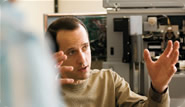Repairing Defective Genes

"Our consortium begins with large scale calculations performed on a parallel supercomputer, and ends with the goal of translating the output of those calculations to treating patients," Scharenberg says. "In my experience, a project of this breadth is a unique scientific enterprise."
When his latest project required a revolutionary new tool, Dr. Andrew Scharenberg couldn't go to the hardware store. He needed to go to the lab and work on creating the tool itself.
Scharenberg, co-director and principal investigator of the Northwest Genome Engineering Consortium (NGEC) and a physician-scientist in the Immunodeficiency Clinic at Seattle Children’s, is pursuing a new approach to gene therapy called gene repair.
The approach involves cutting defective sequences of DNA at specific locations within the gene and delivering corrected sequences to the sites of the snips, enabling the targeted gene to function normally and eliminating the cause of the patient's disease.
Like any job, gene repair requires the right tool — in this case, the right proteins. The sheer scope of this mission also requires bringing together the right combination of scientific expertise. As part of the interdisciplinary focus of the NGEC, Scharenberg and his colleagues at Children’s are teaming up with expert researchers from the University of Washington and the Fred Hutchinson Cancer Center to create a collection of proteins that will perform the required cutting and pasting.
Gene repair promises to make gene therapy a much more effective treatment. As currently practiced, gene therapy involves introducing a whole new gene while leaving the defective gene in place.
However, the new gene usually lands in a random location in the genome far from the natural mechanisms that would normally control it.
That can cause the gene to behave erratically and lead a cell to produce too much or too little of its protein product, creating serious side effects.
Gene repair skirts that problem because it targets the defective gene at its normal location in the genome.
The challenge for Scharenberg and his colleagues is to develop customized proteins — known as homing endonucleases — that know precisely where to do their work depending upon the gene and disease involved.
The proteins they are developing are not normally found in humans. They are mutated versions of proteins encoded by genes found in organisms such as yeasts and fungi.
The only known function of these genes is to copy themselves — a process that involves snipping the DNA of their hosts.
While gene repair ultimately may be useful against a host of diseases, Scharenberg believes immune deficiency disorders represent the best place to start.
That's because the disorders can be corrected by initially repairing genes in relatively few progenitor, or parent, cells.
"Over time, the population of normally functioning cells produced by the progenitor cells will overwhelm the abnormal cells," says Scharenberg. "It's a complicated process, but it's highly promising."